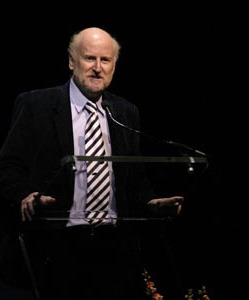NEA Chairman Rocco Landesman is making news again, and I’m not talking about what he said in The New York Times’s Sunday Arts & Leisure piece. It did say that he had become “perhaps more politic” since taking office. And it quoted him as saying he had to cut down on his whining. Both good.
 The article also disclosed that Landesman is “hoping to make an end run” around his budget constraints by forging collaborations with agencies that have more money, like the Housing and Urban Development and Transportation departments. Let’s hope he does get that on down on paper.
The article also disclosed that Landesman is “hoping to make an end run” around his budget constraints by forging collaborations with agencies that have more money, like the Housing and Urban Development and Transportation departments. Let’s hope he does get that on down on paper.
But by paying close attention to what Landesman said on Friday, when he spoke at the Arts Education Partnership’s Spring 2010 Forum, I saw a little more evidence that he has evolved since, well, August.
For a start, then he told the Times that in contrast with his predecessors, who had pointedly spread NEA funds to every Congressional district, he would instead focus on funding the best art. That’s when he made his famous comment about the probable lack of good theater in Peoria. “I don’t know that we have to be everywhere if the only reason for supporting an institution is its geography,” he said.
Fast forward to Friday, when he said:
I have challenged my staff to see if we can make sure that there is at least one arts education grant in every Congressional district.
OK, arts education should indeed be universal, but isn’t he implying that good art isn’t? If he has to make choices about funding the best in one area, shouldn’t he also fund the best in another? Or has Landesman simply learned that it is good politics, if bad policy, to court Congress with NEA funds, no matter how small they are?
Look at it another way: Landesman noted that NEA had $15 million for arts education grants which, divided by 435 Congressional districts, equals less than $35,000 per grant. That’s not even one art teacher’s salary. Maybe larger, innovative pilot projects would have more impact.
In Friday’s speech, he also made this point:
At the NEA, we will shortly be releasing data that shows that arts education drives arts attendance, and the producer in me thinks that butts in seats is reason enough to do anything. But there are more reasons: in addition to audiences, arts education creates arts administrators and artists.
And loosely summarizing experts like Daniel Pink, Howard Gardner and Mark Stern, he said:
The arts provide us with new ways of thinking, new ways to draw connections. They are important social capital, and they help maintain our competitive edge by engendering innovation and creativity. So an arts education grant in every Congressional district is an important goal.
And he went on to endorse the idea of turning STEM, the emphasis on science, technology, engineering and math, into STEAM — adding art. And then on to making it TEAMS, meaning learning based on collaboration, and then on to allowing failure, using “the arts to give the luxury of failure to our students.”
And that brought him to this odd statement: “How many water lilies did Monet paint, trying to get them just right?”
Huh? Not sure that’s what Monet was doing there….
The NEA emailed the speech to me, and it’s not (yet) posted online, so I can’t provide a link. All in all, it shows Landesman’s heart is in the right place. But that may not be enough to make him an effective chairman.
UPDATE, 4/12: The speech is online (thanks to commenter, below) here.
He’s supposed to testify on Capitol Hill on the NEA budget on Tuesday. That ought to be interesting.
